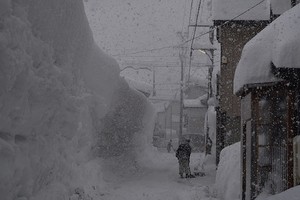By YUKI EDAMATSU/ Staff Writer
December 1, 2022 at 16:56 JST
 Medical workers treat a COVID-19 patient in a hospital in Tokyo’s Bunkyo Ward in September 2021. (Ryo Kato)
Medical workers treat a COVID-19 patient in a hospital in Tokyo’s Bunkyo Ward in September 2021. (Ryo Kato)
As the coronavirus resurges across Japan, hospital beds set aside for patients with COVID-19 have reached occupancy rates of 50 percent or more in 18 prefectures, mainly in eastern Japan.
Just a week earlier, the rates were only that high in nine prefectures.
That 50-percent mark is a deciding factor for prefectures in whether to pursue stricter measures to combat the rise in infections.
The hospital bed data was published at a Nov. 30 meeting by the Cabinet Secretariat and the health ministry’s expert panel on Japan’s pandemic response.
The latest weekly number of new COVID-19 patients reached 1.15 times the previous week, continuing the trend of gradually increasing COVID patient numbers.
The figures show hospital bed occupancy rates rising particularly in northern and eastern Japan. Bed occupancies for COVID-19 patients as of Nov. 29 reached 57 percent in Hokkaido, 61 percent in Miyagi, Ibaraki and Kanagawa prefectures, 65 percent in Saitama Prefecture and 69 percent in Nagano Prefecture.
The government has meanwhile revised the warning categories for the strain that COVID is heaping on the medical system. It has divided them into four categories to prepare for the eighth wave of the pandemic.
A bed occupancy rate of 50 percent is one of the criteria that prefectural officials use to determine whether they have reached level 3, which means medical services are under increasing burden.
Once a prefecture reaches level 3, its governor can declare enhanced measures to deal with the pandemic. After that, they can take steps such as calling on residents to refrain from dining in a group.
But officials also use other criteria to assess the threat level.
They also count a 50-percent occupancy rate of beds set aside for seriously ill COVID-19 patients.
That figure is currently under 20 percent for most prefectures.
Against the backdrop of all this, the government is considering reclassifying COVID-19 into a less-severe infectious disease category.
“I would like experts to express, in an easy-to-understand manner, how they assess the novel coronavirus’ pathogenicity, infectiousness and possibilities of mutation,” said Health Minister Katsunobu Kato.




















A peek through the music industry’s curtain at the producers who harnessed social media to help their idols go global.
A series based on diplomatic documents declassified by Japan’s Foreign Ministry
Here is a collection of first-hand accounts by “hibakusha” atomic bomb survivors.
Cooking experts, chefs and others involved in the field of food introduce their special recipes intertwined with their paths in life.
A series about Japanese-Americans and their memories of World War II